Im trying right now to transfer a bipartite two-mode graph to its one-mode representation. The issue is that I want to conserve node atrributes from the two-mode graph to the one-mode representations. For example a dataframe is given by:
Person EventLocation DurationEvent
Peter Bar 90
Jack Bar 90
Franz Train 20
Franz Bar 90
Laurie Train 20
Jack Train 20
...
Now I want to get persons network using the igraph function bipartite_projection() on the Person and EventLocation columns but I see no ways how to presafe additional node attributes (duration) that might be transfer to edge weights between Persons, e.g. Peter-Jack with weight 90 or Franz-Laurie with weight 20.
Edit: I´ve added the last row to be more precise. The edge "Jack-Franz" would now correspond to 90+20 = 110. But basically my issue is just related how to implement a bipartite_projection which transfers the node attribute of a bipartite igraph-network to the correspoding edge attribute in the one-mode igraph-network.
Edit 2: I just added another example. First, I create a network among persons then I want to add the budget informations to the persons edges implying how much project budget did the both attracted together (the sum of budgets only from different unique projects as weights). Then I wanted to do some further weighted centrality calculations:
person_id <- c("X","Y","Z","Q","W","E","R","X","Y")
project <- c("a","b","c","a","a","b","c","b","a")
budget <- c(100,200,300,100,100,200,300,200,100)
employ.data <- data.frame(person_id, project, budget)
View(employ.data)
sna.complete.list <- employ.data
sna.list.complete.igraph.calc <- graph.data.frame(sna.complete.list)
V(sna.list.complete.igraph.calc)$type <- V(sna.list.complete.igraph.calc)$name%in%sna.complete.list$person_id
sna.list.complete.igraph.calc.one <- try(bipartite.projection(sna.list.complete.igraph.calc, type=V(sna.list.complete.igraph.calc)$type))
sna.statistics.persons <- sna.list.complete.igraph.calc.one[[2]]
plot.igraph(sna.statistics.persons)
EDIT3: I try to reformulate my concern:
Overall Goal: Get an weighted graph (edge values between nodes weighted with some values)
Outline/Data:
Data on people participating in different projects that differ in budget size
Convert bipartite connection graph (People-Project) to one-mode-People-People-graph
Use the budget sizes as weights for the edges between the people.
BUT for two people this value should only account for the sum of participating at unique projects. Thus, if A and B are only connected by project x of budget size 100 should result in an edge-weight of 100. If they also participate in another project with value 20, the result should be 120 etc.
I tried to transfer this information during using bipartite.projection but failed or couldn´t implement this information afterwards.

